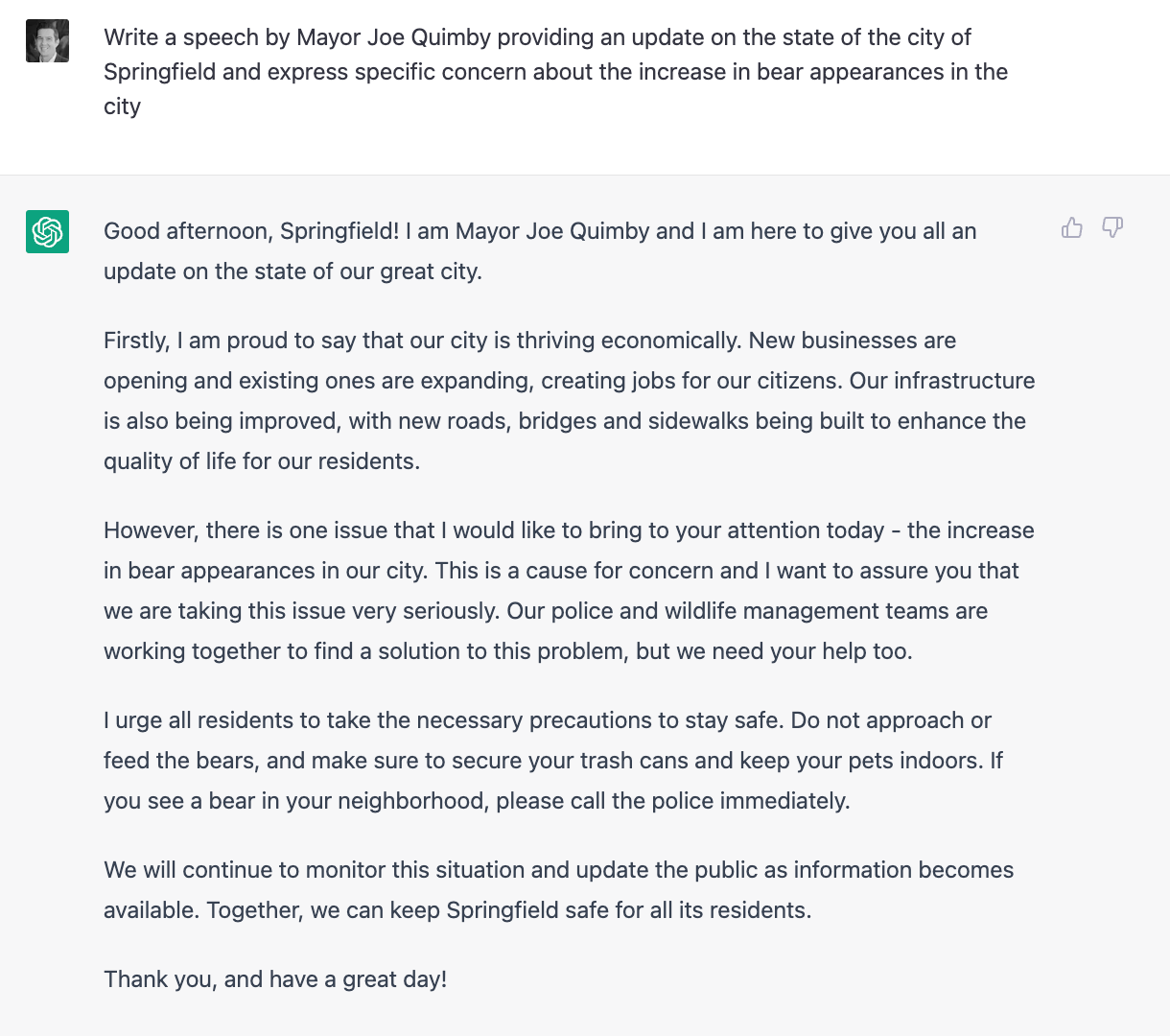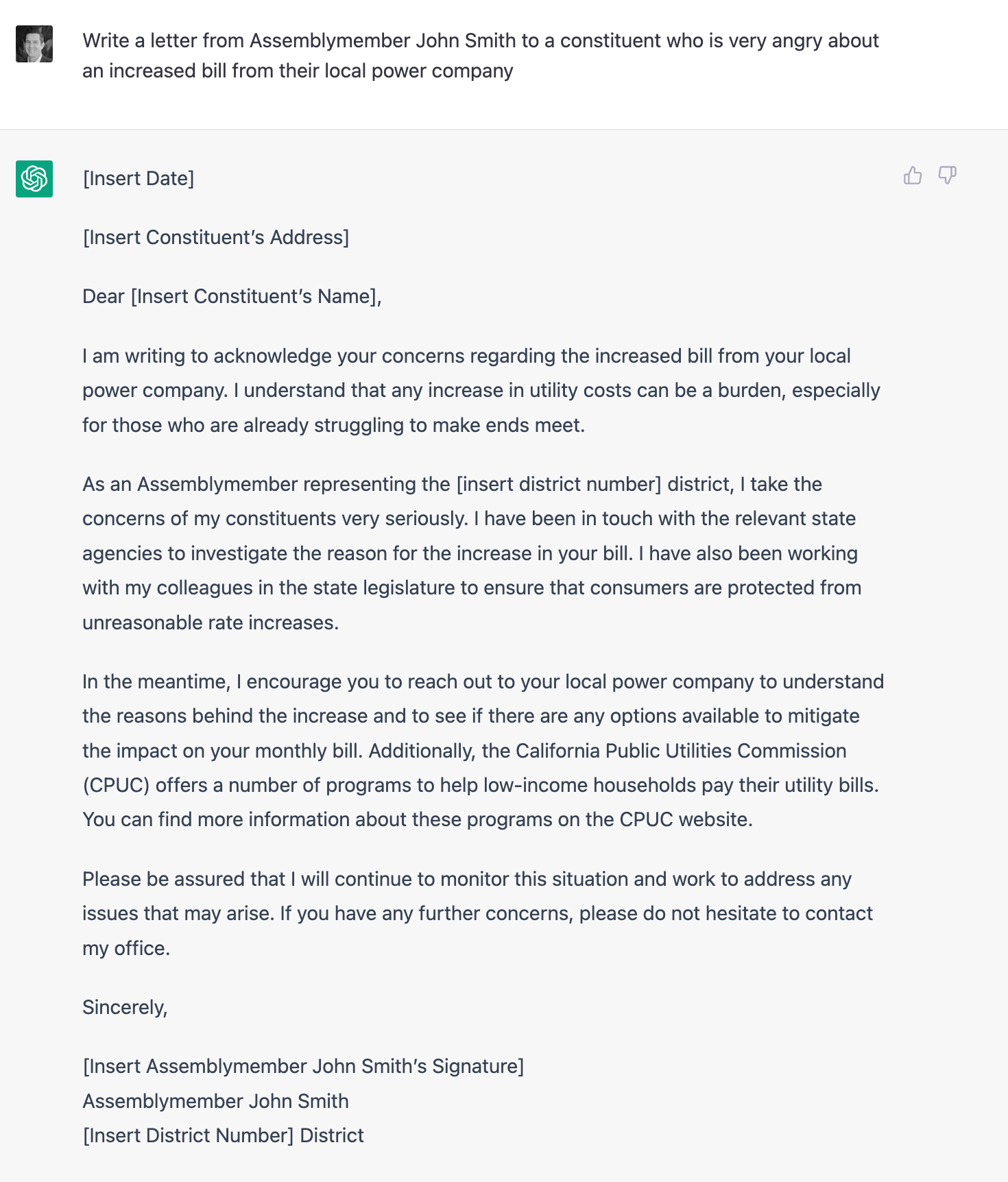Could Artificial Intelligence run a legislative office?

I will start this post with a quote from former GitHub CEO Nat Friedman, which he gave in an interview:
I left GitHub thinking, “Well, the AI revolution’s here and there’s now going to be an immediate wave of other people tinkering with these models and developing products”, and then there kind of wasn’t and I thought that was really surprising. So the situation that we’re in now is the researchers have just raced ahead and they’ve delivered this bounty of new capabilities to the world in an accelerating way, they’re doing it every day. So we now have this capability overhang that’s just hanging out over the world and, bizarrely, entrepreneurs and product people have only just begun to digest these new capabilities and to ask the question, “What’s the product you can now build that you couldn’t build before that people really want to use?”
As someone who works in politics, I had to of course ask that question through the lens of politics. And the more specific question would be: to what extent could the development of Artificial Intelligence (AI) impact politics?
So I started thinking about the ways it might impact how a legislative office is run.
Take a moment to look at the prompt I typed into ChatGPT, a popular AI language application. And then read the response it generated:

This is probably close to what an actual press release on this topic would look like, presuming Assemblymember Smith was indeed against the tax increase. (The model assumed this politician was from California, for whatever reason.)
As mentioned above, this was generated using ChatGPT, an AI language model built upon GPT-3:
GPT-3, or the third-generation Generative Pre-trained Transformer, is a neural network machine learning model trained using internet data to generate any type of text. Developed by OpenAI, it requires a small amount of input text to generate large volumes of relevant and sophisticated machine-generated text.
And here's a bit more of a layman's explanation:
GPT-3 is considered as the first step by some in the quest for Artificial General Intelligence. It has captured more attention than any other AI model out there. Its sheer flexibility in performing a series of generalized tasks with near-human efficiency and accuracy is what makes it so exciting. It was released in the form of an API with the intention to give data scientists, developers, and people of all walks and professions around the world unprecedented access to one of the world’s most powerful language models.
The model was created by OpenAI, a company at the frontier of artificial intelligence R&D. Since its initial release in July 2020, developers around the world have already found hundreds of exciting applications for GPT-3 that have the potential to elevate the ways we communicate, learn, and play. It is capable of solving general language-based tasks with ease and can move freely between different text styles and purposes.
I imagine most communications professionals working in legislative offices have grown pretty capable of writing press releases fairly quickly. But in the example above, ChatGPT was able to generate one in a manner of seconds. And it's not far off from what the "correct" release would be, once you account for slight editing and adjustments to reflect potential political nuances.
I should note that the issue of tax increases is relatively straightforward. There are other issues that are more complex, and the legislator's sending out press releases may have more nuanced views than what ChatGPT would presume.
The ChatGPT application is designed for mass appeal and usability. It is essentially an introductory mechanism for exposing the general public to the capabilities of AI generally and GPT-3 specifically.
However, the underlying GPT-3 model can be licensed, trained, and refined, based on the custom needs of a given individual, organization...or legislator.
In other words, if there was a desire to do so, a legislative office could essentially build or design their own GPT-3 AI model, and effectively train it by uploading dozens or hundreds or thousands of press releases that have been distributed by this politician over the years. After this process, the model would more effectively learn the voice of the legislator, the positions that have been taken on past issues, and the level of passion or concern that is tied to each issue.
(I am simplifying how this process works a bit – just know it is very possible to do this with the right technical know-how.)
For example, GPT-3, while "reading" past press releases, might learn that tax hikes generate more anger from the legislator relative to more mundane issues. GPT-3 could detect this sentiment and take this into account for future releases. Anytime a vote on tax increases is made, a release could be automatically generated, briefly looked over by a set of human eyeballs or two, and sent for distribution.
Of course, press releases aren't the only thing that a legislative office has to generate.
What about talking points or a speech to a local community group? Here's another fun example that was written in a few seconds:

Let's take it up a notch and consider how constituent correspondence could be handled.
If you've ever worked in a legislative office, particularly a Congressional office, you likely know that most original drafts of constituent correspondence are drafted by interns or staff. For those who have not worked in a legislative office, I am unveiling a dispiriting truth: Your Congressmember is not personally reading and responding to each piece of constituent correspondence the office receives.
The process goes something like this:
1) A message is received from a constituent expressing their position on a certain issue.
2) An intern or staffer references past letters sent out by the legislator to determine if a response already exists. (This often takes time.)
3) If so, the letter may get re-used. If not, new content needs to be generated. If a similar issue has been written about, perhaps some of the language is re-used.
4) A draft is approved by a staff member.
5) A draft is (sometimes) approved as final by the legislator, but may also be approved as final by a senior staff member.
GPT-3 could basically remove steps 1-3. You would still want a round or two of approvals. (Unless you truly wanted to become "liberated" by this technology.)
With this knowledge in hand, look at the following response to a piece of (imagined) constituent correspondence:

(Again, California.)
This took about 10 seconds to generate. And as a response to this imagined constituent, it's practically perfect. It expresses empathy. It shows action. And it provides a possible solution for the upset constituent.
Now, just as with the press releases, an office could upload (into our custom GPT-3 model) past correspondence written to constituents that has gone out with the legislator's name on it over the years. Doing so would also effectively capture the voice and past positions of the legislator.
In some offices, the flood of constituent correspondence is significant. Some offices may receive hundreds if not thousands of messages and pieces of mail per day. It's a complete flood of information that is often difficult to sort through and gain a pulse on the district.
But once again, AI can come to the rescue!
Take a look at Viable (this is, unintentionally yet regrettably, a free advertisement), a company that has built a customer sentiment product on the foundation of GPT-3. Utilizing GPT-3, users can upload thousands of bits of qualitative feedback from individuals, and the platform can read, digest, analyze, and summarize the overall sentiment of the feedback (as you read the description below, substitute "constituents" where it says "consumers"):
Viable generates automated analysis reports of your customer feedback. The reports give you an understanding of what your customers are telling you across all your feedback in an automated way.
Gone are the days of manually reading through and tagging every helpdesk ticket, survey response, call transcript, app review, or tweet. With every piece of feedback from customers analyzed, you have in your hands a powerful overview of all your feedback, backed by your own data.
The company already has a product that would allow an office to analyze the overall sentiment of comments on a Facebook page. That alone provides an excellent use case for a legislative office.
Now, rather than having staff and/or interns cull through thousands of messages in an attempt to discern what constituents are most concerned about, an office could instead use AI in order to do it.
Imagine a legislator receiving a weekly report providing a broad overview of the issues their constituents care most about. That would be immensely valuable.
These ideas aren't just theoretical. Tomorrow, someone could build software or a web application that could utilize all the features described above into one bundle. (If you read this and are inspired to build such an application, I only ask for 1% of royalties.)
Of course, all of this generated content should still be examined by a living, breathing human to ensure accuracy and to avoid any political pitfalls. But that step already happens anyway (hopefully!).
As mentioned at the beginning, this article is not to endorse using AI to run an office. There are credible arguments to be made that it would weaken the democratic connection between constituent and elected official by essentially inserting a computer in between the two.
But I also wouldn't be surprised to see it utilized in a manner similar to how companies and individuals are already using it to make their work lives easier and more efficient, just as Word processors, databases, and e-mail have made operating a legislative office easier over the years.
And by the way, if you were impressed by what GPT-3 can do, GPT-4 is supposedly right around the corner.

Member discussion